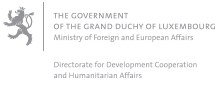- Home
- Preface
- European Year for Development
- COP21 and the Paris Agreement
- I. Luxembourg’s official development assistance in 2015
- II. Cooperation with the main partner countries
- III. Regional cooperation and cooperation with other countries
- IV. Multilateral cooperation
- V. European Union
- VI. Cooperation with non-governmental development organisations
- VII. Humanitarian action
- VIII. Programme support
- IX. Development education and awareness raising
- X. Inclusive finance
- XI. Evaluation
- XII. Report on the progress of the work of the Interministerial Committee for Development Cooperation
- Appendices
VII. Humanitarian action

Nigerian refugees in the Minawao refugee camp in Cameroon. Credit: Sofia Engdahl, UN World Food Program

Training to roll out a Regular kit at Let’s Net 2015 in Schimpach
emergency.lu
In February 2015, in response to the enormous destruction caused by the category 5 Cyclone Pam in Vanuatu, two volunteers from the Luxembourg emergency services and an emergency.lu satellite telecommunication system were rushed to the Pacific. This rollout – at the UN’s request – assisted the Vanuatu government to re-establish communications services between the capital, Port Vila, and the island of Tanna.
Despite logistical challenges, the system was transported by boat to Tanna and installed in Isangel on 29 March. This terminal enabled the government micro-computer network to be re-established and FM radio contact to be made between Port Vila and the damaged islands. At the same time, the terminal supplied broadband internet to the humanitarian organisations working on the island of Tanna.
In April 2015, emergency.lu in Nepal was rolled out in response to the earthquakes in Nepal in order to re-establish telecommunication services in the affected region. Through close collaboration with the Belgian emergency services B-FAST, three volunteers from Luxembourg emergency services and a mobile satellite telecommunications system were dispatched on board a Belgian military aircraft bound for Katmandu on Sunday, 26 April. A fourth member of the emergency services left on 27 April from Dubai.
In addition to this, two systems on their way back to Luxembourg from Vanuatu were redirected to Nepal and arrived there on 3 May. They supplied connectivity in various districts in line with the needs identified by the “Emergency Telecommunications Cluster” (ETC).
In the Chautara district, which was severely affected by the earthquake, emergency.lu supplied free connectivity to the humanitarian organisations working in a camp set up by the IHP (International Humanitarian Partnership) network at the request of the United Nations.
The final emergency.lu kit was dismantled and repatriated in November 2015.
In 2014, five terminals were rolled out in Sierra Leone and Guinea in response to the Ebola epidemic. This equipment was operational until September 2015 for the needs of the ETC, the WFP and the B-LIFE mobile laboratory.
In November 2015, in response to a request from the World Food Program, a maritime antenna was installed on a boat housing the UN teams in charge of the emergency operation in Yemen. This antenna is not a standard emergency.lu antenna but is equipped with a system which automatically maintains its satellite link regardless of the boat’s movements; it provided connectivity to the humanitarian actors working on the boat in question until the end of February 2016.
In South Sudan, where emergency.lu has been present since January 2012, three systems are currently in operation; one for UNICEF in Bor and the other two for ETC in Bentiu and Mingkaman.
As they do every year, the emergency services volunteers took part in a number of exercises and simulations at the European and international level, using and testing out the emergency.lu equipment.
The Ministry, in close collaboration with the emergency services department and the national college of civil protection, organised and implemented the “Let’s Net” training course for ETC technicians. Twenty colleagues from various agencies and organisations took part in this training course in Schimpach.
As part of the emergency.lu project, various applications were also developed in 2015:
- The UNDAC Mission Software application, which enables improved coordination of the UNDAC teams deployed by OCHA through a file exchange. This application is connected to the “emergency.lu back-end.”
- The ETC Reporter application, which enables the WFP to track people and vehicles in the field and to visualise them on a map, to use mapping tools, to annotate the maps, to load photos and videos and to carry out all sorts of assessments via a solution which is easily adapted to the various needs and sectors.
- In 2014, the Ministry and UNHCR decided to digitise the UNHCR “bible”, the Emergency Resource (formerly called the Emergency Handbook). This huge volume, which details all the standards, guidelines, working methods, etc. that an employee on the ground needs, existed previously only in paper form (of about 500 pages). The application was officially launched in 2015.
In 2015, a total of 3,8 million euros was spent from the DCF on the first year of the new contract of the emergency.lu project (2015-2020).
Added to this is an amount of 250 582 euros spent on covering the costs of rolling out the telecommunications systems, especially the costs of transporting the equipment and expenses connected with the missions and exercises.

